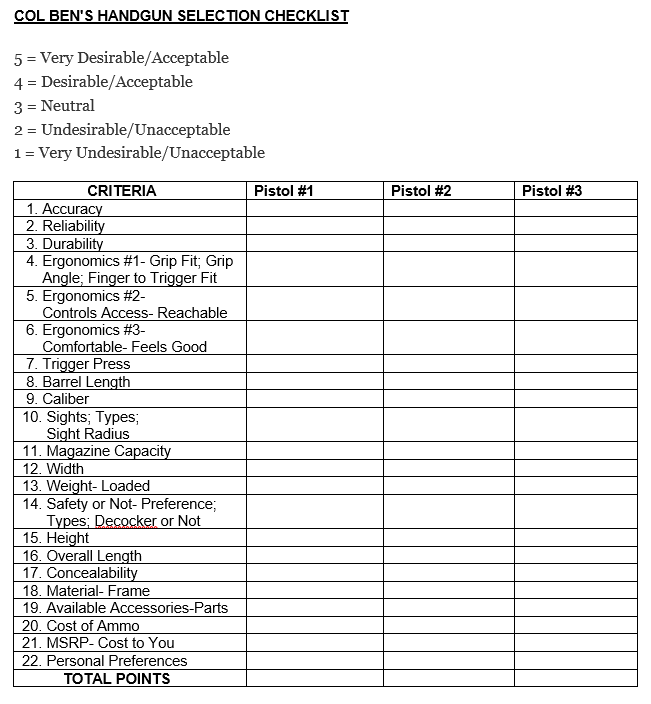This is not a picture of your ideal handgun and certainly does not match any criteria that I have. There are, however, certain very necessary attributes you really need to consider when selecting your personal gun. Often, we just see a gun we like and buy it. Sometimes because Uncle Tom or Aunt Sally said that is the best gun since sliced bread, we buy it. Our range buddy or the gun shop salesperson said that is the gun the pros use or that police officers use, so you cannot go wrong. Other times we just focus on one or two must-have factors that we prefer, then we seek out guns that match just those two things. What is your approach to selecting your personal handgun? I want to share my approach and Checklist to help you.
Very rarely, do we take a big picture, total perspective objective approach, specify our use for the gun, decide our criteria up front, prioritize them, and then evaluate the 3 or 4 gun alternatives that we are considering against a standard set of criteria. Frequently, we do not even shoot the guns we are considering, but just assume they will perform right for us. If we do shoot our gun options, we do not test shoot all of them using a standard drill for all guns we are considering. In essence, we just emotionally, subjectively, and irrationally select THE “apple” or do not compare the types of apples, or compare an apple with an orange. What I am saying is that we should take more time up front and have a more objective, systematic, structured way of selecting our personal handgun, rather than a seat-of-the-pants approach. We should have our goal/use defined, criteria specified, factors identified and ranked, and a way of objectively evaluating each alternative against the same standards. This not “much ado about nothing,” as Shakespeare would say. Yes, it takes time and effort to do this, but just think what you are doing. You are selecting a tool that could possibly save your life. You must count on it to do its job. It certainly is worth the focus. I want to share my approach and you can decide if you want to use my Checklist or reduce the factors down to your set, etc. Hope it helps!
When selecting my personal handguns, I first decide on my primary use for the gun and identify several factors and criteria that are important to me, prioritize them, and use a standard evaluation scale to evaluate each gun option against each criterion. For years, I have used a standard 5-Point Likert Scale (given below) to evaluate each of my following 22 factors or Criteria for each pistol I am considering. It is important to identify specifications and also use a standard shooting drill for all guns to compare the same factors for each. My Criteria and factors are generally defined below to help. So, I assign my points to each criterion, then total all points for all 22 factors for each pistol and compare them. The pistol with the highest Total Points is probably the pistol for my specific purpose, if I honestly assessed each factor. For your different purposes or use for the gun, you might delete some of the below factors or add your own. I do that sometimes, like reduce the 22 to 7-8. The 5-Point Scale for each criterion is:
CLICK HERE TO DOWNLOAD THE PDF VERSION OF THIS CHECKLIST.
Here are some General Definitions of each of the 22 criteria to help you decide on your personal pistol.
- ACCURACY – able to hit the target as desired for your first shot out-of-the-box without gun modifications; use the same distance, drill, grip, speed, target aimpoint, etc. for each gun
- RELIABILITY – consistency over repeated trials with the gun; can you shoot it today, tomorrow, & next week with very similar results
- DURABILITY – are there indications the gun will last a long time; mechanical construction; quality of materials used; manufacturer’s workmanship, design & detail
- ERGONOMICS #1- GRIP/FIT – Proper fit of gun’s grip to your particular hand & finger size
- ERGONOMICS #2- CONTROLS – Can you easily reach the slide lock lever, safety, mag release, various controls, etc.
- ERGONOMICS #3- COMFORT – Does the gun feel good in your hand & when shooting it is the recoil physically acceptable to handle when applying shooting fundamentals
- TRIGGER PRESS – Does it have a short and light trigger press, reset, and travel, as desired, or do you prefer its long and hard press
- BARREL LENGTH – appropriate for your use and preferences; generally a barrel length under four inches causes more felt recoil, movement, etc. & may affect accuracy; note ammo
- CALIBER – appropriate for your use and preferences; I prefer 9mm because of less movement, less felt recoil, and the positive affects on accuracy
- SIGHTS – appropriate for your use and preferences; medical conditions and eyesight affects sights chosen; I like night sights and fiber optic front sights
- MAG CAPACITY – appropriate for your use and preferences; to engage multiple targets/bad guys you may need a higher mag capacity; strongly influenced by gun use
- WIDTH – a thinner gun is optimal & a primary factor for concealed carry purposes
- WEIGHT – too light a gun amplifies movement & handling recoil & may affect accuracy; a polymer frame and a steel frame affect not just the carry weight, but also movement & accuracy; gun use is a consideration for this factor
- SAFETY – some prefer a safety on a home defense gun or a carry gun, while others do not; some say training is the key to properly using a safety or even having one; some like grip safeties & some do not; consider type of safety, like firing pin block, trigger, drop, hammer, etc.
- HEIGHT – how tall the gun is; hand size is just one consideration, as is use
- LENGTH – longer barrels allow bullets to exit the barrel with higher velocity & are usually flatter shooting at longer ranges; since they contribute to taking longer for the bullet to drop
- CONCEALABILITY – certainly size, dimensions, contoured shape, grips affect how well you can hide a gun; minimize bulges for better concealability; width is key vs. length
- MATERIAL – polymer is usually lighter than steel and relates to your use & abilities
- ACCESSORIES – how readily available are parts, mags, holsters, pouches, ammo, etc.
- COST OF AMMO – the lower the cost of ammo, the more often you can practice; generally, 9mm ammo costs less than .40, .45, .380, .38 ammo
- COST OF GUN – comparable to competing models, is the gun reasonably priced for the same features & specifications; consider not just MSRP, but actual purchase cost on the street
- PERSONAL PREFERENCES – what unique, special features, characteristics, or subjective qualities and factors do you individually prefer; maybe appearance is a factor or not.
What criteria and system do you use? Continued success!
Photo by U.N. The Knotted Gun sculpture by Carl Rutersward, Swedish Artist.
* This personal opinion article is meant for general information & educational purposes only and the author strongly recommends that you establish your own criteria based on your personal needs, goals, purpose, and priorities. It should not be relied upon as accurate for all shooters & the author assumes no responsibility for anyone’s use of the information and shall not be liable for any improper or incorrect use of the information or any damages or injuries incurred whatsoever.
© 2015 Col Benjamin Findley. All Rights Reserved. This article may not be reprinted or reproduced in whole or in part by mechanical means, photocopying, electronic reproduction, scanning, or any other means without prior written permission. For copyright information, contact Col Ben Findley at [email protected].










